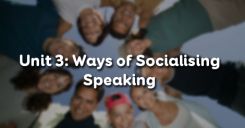Bài học Unit 3 Lớp 12 Ways of Socialising phần Reading xoay quanh nội dung về các cách giao tiếp trong cuộc sống, qua đó giúp các em học hỏi những kinh nghiệm giao tiếp hàng ngày. Thêm vào đó, nội dung bài học tập trung giúp các em kỹ năng đọc lấy thông tin khái quát và thông tin chi tiết cho vấn đề cần tìm hiểu.
Tóm tắt bài
1.1. Before You Read Unit 3 Lớp 12
Look at the pictures and answer the following questions. (Nhìn vào những bức tranh và trả lời câu hỏi)

1. What are the people in the picture doing? (Những người trong tranh đang làm gì?)
2. What will you do and/or say if (Bạn sẽ làm gì và/hoặc nói gì nếu)
- you want to get your teacher's attention in class? (bạn muốn thu hút sự chú ý của giáo viên trong lớp?)
- you need to ask someone a question, but they are busy talking to someone else? (bạn cần hỏi ai đó điều gì nhưng họ đang bận nói chuyện với một người khác?)
Guide to answer
1.
- In the upper picture, two men are shaking their hands and saying the greetings. At this time, other people are also talking together.
- In the lower picture, people are waiving and saying "goodbye" to one another.
2.
- In class to get my teacher’s attention, I usually raise my hand.
- To ask someone a question when they’re busy talking to someone else, I will say to him/ her “I’m sorry. I’d like to talk to you,” or “I'm sorry. I have something to talk to you”, and at the same time I say to their partner “I'm sorry.”
1.2. While You Read Unit 3 Lớp 12
Read the passage and do the tasks that follow (Đọc bài đọc và làm những bài tập bên dưới)
- Bài đọc được phân chia theo 4 phần tương ứng với nội dung
- Đoạn 1: Giới thiệu một cách thức giao tiếp không lời "vẫy tay"
- Đoạn 2: Giao tiếp không lời trong tình huống thân mật
- Đoạn 3: Giao tiếp không lời nhẹ nhàng
- Đoạn 4+5: Cách thức khác đê thu hút sự chú ý
1.2.1. Unit 3 Lớp 12 Reading Task 1
Give the Vietnamese equivalents to the following words and phrases. (Tìm những từ ngữ tiếng Việt tương đương với những từ và cụm từ dưới đây)
- verbal................. rude..........................
- non-verbal...................... informality .............................
- attract someone's attention ...................... approach ...........................
- impolite............................ a slight nod will do ................................
Guide to answer
- verbal: bằng lời (hữu ngôn)
- non - verbal: không lời (phi ngôn)
- attract someone's attention: thu hút sự chú ý của ai
- impolite: bất lịch sự
- rude: thô lỗ
- informality: thân mật, không trang trọng
- approach: đến gần, tiếp cận
- a slight nod will do: một cái gật đầu nhẹ là đủ
1.2.2. Unit 3 Lớp 12 Reading Task 2
Decide which of the three option below is the best title for the passage. (Xác định trong 3 lựa chọn sau, lựa chọn nào phù hợp nhất cho tựa đề bài đọc)
A. Attracting Attention: Non-verbal Cues (Thu hút sự chú ý: Sự ra hiệu)
B. Attracting Attention by Waiving (Thu hút sự chú ý bằng cách vẫy tay)
C. The Best Ways of Attention (Những cách tốt nhất của việc thu hút sự chú ý)
Guide to answer
A. Attracting Attention: Non-verbal Cues
1.2.3. Unit 3 Lớp 12 Reading Task 3
Answer the following questions. (Trả lời những câu hỏi bên dưới)
1. What can we do when we want to attract someone's attention? (Chúng ta có thể làm gì khi muốn thu hút sự chú ý từ một ai đó?)
2. What are considered to be big, obvious non-verbal signals? (Những cách giao tiếp không lời nào được xem là nồng nhiệt và gây chú ý nhất?)
3. What can we do if we want to attract the waiter's attention? (Chúng ta có thể làm gì nếu muốn thu hút sự chú ý của người phục vụ bàn?)
4. If you are walking across the schoolyard and see your teacher approaching you, what can you do to attract his or her attention? (Nếu bạn đang đi băng qua sân trường và nhìn thấy giáo viên của bạn, bạn có thể làm gì để thu hút sự chú ý của thầy hoặc cô ấy?)
5. Why shouldn't you point at the person or thing you want your friend to look at once you're got his or her attention? (Tại sao bạn không nên chỉ trỏ vào người hoặc vật mà bạn muốn bạn của mình nhìn khi bạn thu hút được sự chú ý của người ấy?
Guide to answer
1. When we want to attracl someone’s attention, we can use either verbal or non-verbal communication.
2. They are strong actions that can he easily seen in the distance such as: jump up and down, waive,...
3. If we want to attract a waiter’s attention, we can wait until he passes near us, catch his eyes and nod slightly to let him know we would like him to come to our table. Or we can raise our hand slightly to show we need assistance.
4. We can use a small friendly wave to attract his / her attention.
5. Because pointing at someone is usually considered rude.
1.3. After You Read Unit 3 Lớp 12
Word in pairs. Discuss the meanings of whistling and hand-clapping in Vietnamese culture. (Làm việc theo cặp. Thảo luận ý nghĩa của việc huýt sáo và vỗ tay trong văn hóa Việt Nam)
Guide to answer
A. Do you know about the meanings of whistling and hand-clapping in Vietnamese culture?
B. Yeah, a little bit. These two actions have quite different meanings. I think whistling is a signal to show we feel happy or satisfied with something.
A. At present, I know that for teenagers; whistle to express their disapproval or protest.
B. I agree with you, but only for teenagers. To adults or learned or educated people, they never whistle to show their disapproval or dissatisfaction.
A. That’s right. Whistling in crowds is considered impolite or even rude.
B. What about hand-clapping?
A. In my opinion, hand-clapping is an action used to show one's approval, agreement or enjoyment.
B. But I've heard there is difference between common hand-clapping and slow hand-clapping.
A. Oh really? I haven’t heard about that, but as I guest slow hand-clapping shows the applause or cheer.
B. All right, slow hand-clapping with shouts can be used to express strong disapproval or protest.
A. Thus, we should be careful when we clap our hands.
B. Well, I think so.
1.4. Bài dịch Reading Unit 3 Lớp 12
Muốn thu hút sự chú ý của một ai đó để có thể trò chuyện cùng họ, chúng ta có thể dùng những hình thức giao tiếp bằng lời hoặc không lời. Hãy cùng xem xét cách giao tiếp không lời trong tiếng Anh. Có lẽ cách phổ biến nhất để thu hút sự chú ý của một người là vẫy tay. Chẳng hạn, nếu chúng ta đang dự một bữa tiệc náo nhiệt và nhìn thấy một người bạn đứng ở cửa cách đó khoảng 20 mét, chúng ta có thể giơ tay và vẫy như một dấu hiệu cho biết chúng ta đã thấy cô ấy.
Nhưng trong tình huống thế này làm cách nào để chúng ta có thể vẫy tay? Già sử bạn đang ở sân bay, và bạn thấy anh trai bạn bước xuống máy bay và bắt đầu đi về hướng bạn. Nếu bạn mừng rỡ, bạn có thể nhảy cẫng và vẫy tay liên tục để thu hút sự chú ý của anh ấy. Đây là tình huống mà cách giao tiếp không lời nồng nhiệt và gây chú ý được xem là thích hợp nhất.
Tuy nhiên, trong một vài tình huống giao tiếp mà những hình thức gây chú ý không bằng lời nhẹ nhàng lại thích hợp hơn. Chẳng hạn, trong một nhà hàng, nếu chúng ta muốn thu hút chú ý của một nhân viên phục vụ, chúng ta có nhiều cách thực hiện. Chúng ta có thể chờ cho đến khi anh ta đi đến gần, nhìn vào mắt anh,ấy và gật đầu nhẹ để cho anh biết chúng ta muốn anh đến với bàn cùa chúng ta. Hoặc chúng ta có thể nhẹ nhàng giơ tay để cho biết chúng ta cần sự giúp đỡ. Chúng ta không huýt sáo hay vỗ tay để gây sự chú ý của anh ấy. Điều đó được xem là mất lịch sự và thậm chí là thô lỗ.
Trong hầu hết các tình huống giao tiếp sự thân mật cho phép đưa tay lên và vẫy nhẹ nhàng. Chẳng hạn, nếu bạn đi ngang sân trường và thấy giáo viên của bạn đang tiến đến, cái vẫy tay thân mật nhẹ nhàng để gây sự chú ý của thầy /cô ấy là đủ.
Một khi đã gây được chú ý của một người bạn, bạn không nên chỉ vào người hay vật bạn muốn anh / cô ấy nhìn vào. Một cái gật đầu nhẹ là đủ. Chỉ vào ai thường bị xem là thô lỗ. Dĩ nhiên có nhiều lúc chỉ trỏ hoàn toàn có thể chấp nhận được, ví dụ như khi giáo viên muốn sự chú ý của người nào trong lớp. Giáo viên thường chỉ vào học sinh đó và nói. "David, em đọc câu tiếp theo nào" Sự chỉ ở đây không phải vô lễ, đơn thuần là cách gây sự chú ý của một người.
Bài tập minh họa
Read the following test carefully and do the tasks
The body language people use often communicates more about their feelings than the words they are saying. We use body movements, hand gestures, facial expressions, and changes in our voice to communicate with each other. Although some body language is universal, many gestures are culturally specific and may mean different things in different countries.
- If you want to give someone the nod in Bulgaria, you have to nod your head to say no and shake it to say yes – the exact opposite of what we do! In Belgium, pointing with your index finger or snapping your fingers at someone is very rude.
- In France, you shouldn’t rest your feet on tables or chairs. Speaking to someone with your hands in your pockets will only make matters worse. In the Middle East, you should never show the soles of your feet or shoes to others as it will be seen as a grave insult. When eating, only use your right hand because they use their left hands when going to the bathroom.
- In Bangladesh, the ‘thumbs-up’ is a rude sign. In Myanmar, people greet each other by clapping, and in India, whistling in public is considered rude.
- In Japan, you should not blow your nose in public, but you can burp at the end of a meal to show that you have enjoyed it. The ‘OK’ sign (thumb and index finger forming a circle) means ‘everything is good’ in the West, but in China it means nothing or zero. In Japan, it means money, and in the Middle East, it is a rude gesture.
Task 1
Match the meaning of some bold words
1. hand gestures a. thở dài
2. facial expressions b. cái gật đầu
3. the nod c. biểu cảm khuôn mặt
4. thumbs-up d. cử chỉ cánh tay
5. blow your nose e. dấu hiệu đồng ý
Key
1-d ; 2-c ; 3-b ; 4-e ; 5-a
Task 2
Answer some questions
1. What body language can we use to communicate with each other?
2. What do you do if you want to give someone the nod in Bulgaria?
3. What is the meaning of the "OK" sign?
Key
1. We can use body movements, hand gestures, facial expressions, and changes in our voice to communicate with each other.
2. If you want to give someone the nod in Bulgaria, you have to nod your head to say no and shake it to say yes – the exact opposite of what we do.
3. The ‘OK’ sign (thumb and index finger forming a circle) means ‘everything is good’ in the West, but in China it means nothing or zero. In Japan, it means money, and in the Middle East, it is a rude gesture.
Task 3
Choose the best answer that express the most suitable for the title of the passage
A. How to communicate with each other
B. Body language and cultural differences
C. Meaning of the signal of communication
Key
B. Body language and cultural differences (Ngôn ngữ cơ thể và sự khác nhau về văn hóa)
3. Bài tập trắc nghiệm Reading Unit 3 Lớp 12
Như vậy là các em đã xem qua bài giảng phần Reading Unit 3 Lớp 12 Ways of Socialising về phương cách giao tiếp. Để rèn luyện kỹ năng đọc hiểu về đề tài phương thức giao tiếp mời các em tham gia thực hành Trắc nghiệm Unit 3 lớp 12 Reading.
-
Câu 1: Read the passage carefully, then choose the correct answer.
Vietnamese generally shake hands when greeting and parting. Using both hands shows respect, as does a slight bow of the head. In rural areas, elderly people who do not extend their hand are greeted with a slight bow. Women are more likely to bow the head slightly than to shake hands. Vietnamese names begin with the family name and are followed by a given name. For example, in the name Nguyen Van Duc, Nguyen is the family name. People address one another by their given names, but add a title that indicates their perceived relationship to the other person. These titles are family related rather than professional. Among colleagues, for example, the younger of the two might combine the given name with the title of Anh (“Older Brother”). A basic greeting combined with the given name and title is Xin chao (“Hello.”). Classifiers for gender and familiarity are also combined with the greeting. In formal meetings, business cards are sometimes exchanged on greeting.
Vietnamese have a strong sense of hospitality and feel embarrassed if they cannot show their guests full respect by preparing for their arrival. Therefore, it is inappropriate to visit a home without having been invited. Gifts are not required, but are appreciated. Flowers, incense, or tea may be appropriate gifts for the hosts. Hosts also appreciate a small gift for their children or elderly parents.
Which of the following is not true?
- A. In most cases, Vietnamese greet each other with a handshake.
- B. To show respect, they do a slight bow while using both hands to shake.
- C. Vietnamese women never shake hands, so they bow the head slightly when greeting.
- D. Elderly people in rural areas do not often shake hands when greeting and saying good-bye.
-
- A. A family name, a given name, and then a middle name
- B. A given name, middle name, and then a family name
- C. A middle name, a given name, and then a family name
- D. A family name, a middle name, and then a given name
Câu 3-5: Mời các em đăng nhập xem tiếp nội dung và thi thử Online để củng cố kiến thức về bài học này nhé!
4. Hỏi đáp Reading Unit 3 Lớp 12
Trong quá trình học tập nếu có thắc mắc hay cần trợ giúp gì thì các em hãy comment ở mục Hỏi đáp, Cộng đồng Tiếng Anh HOC247 sẽ hỗ trợ cho các em một cách nhanh chóng! Sau bài học Reading này các em chuyển qua bài học Unit 3 Lớp 12 Ways of Socialising - Speaking kế tiếp. Chúc các em học tốt!
-- Mod Tiếng Anh 12 HỌC247













